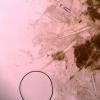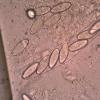
20-11-2012 12:54
Hi allCan anyone confirm that this is L macrotichu

19-11-2012 23:43
 Edit Szilvásy
Edit Szilvásy
Hi all!I bring these specimens asking for your hel

20-11-2012 01:06
Esquivel-Rios EduardoHy All.I found this yellow-orange Hypocrea in a d

19-11-2012 23:30
 Edit Szilvásy
Edit Szilvásy
Hi all! I bring these specimens asking for your h

02-11-2012 21:23
 Michel Hairaud
Michel Hairaud
BonsoirHi to all, Cette espèce récoltée sur feu

19-11-2012 17:09
Bonjour à tous,Lac des Rouges Truites, Jura, 2.10

19-11-2012 16:55
Tourbière du Lac des Rouges Truites, Jura, 2.11.1

19-11-2012 16:30
Bonjour à tous,Voici quelques espèces récoltée

17-11-2012 20:41
Hi to allHave you a modern description of Anthosto
Can anyone confirm that this is L macrotichus? It was growing on deer dung and with non septate hairs up to 500um long, narrowly ellipsoid spores (20-22 x 7.5-8.5)which look to have a granular sheath it looks right but it is a brighter orange than I would have expected.
There were some other apothecia which were much paler.
Thanks
Mal

Measures that you give to L.macrotrichus seem to be those given by the authors. Bezerra and Kimbrough even give hair lengths from 300 to 1000 microns. Apothecia color may vary.
?
Regards.
Michel
Mal

regards,
björn
Thanks. It is nice to get confirmation on the sheath, which is not mentioned in any reference I have seen.
Mal

Thank you for the key to Malcom, because I have a bad scanner.
Michel.?
La longueur des poils n'est pas un caractère de détermination fiable chez Trichobolus macrotrichus Rea. En effet j'ai récolté cette espèce, très commune au printemps sur excréments de chevreuil, à de très nombreuses reprises, durant plus de 20 ans. Sur toutes ces récoltes deux seulement présentaient quelques exemplaires avec des poils supérieurs à 600 ?m.
J'ai décrit cette espèce dans le détail, dans le Bulletin Suisse de Mycologie 2009 (6) : 222-226. Sous le titre explicite suivant: Lasiobolus macrotricus, une espèce stercorale qui ne porte pas particulièrement bien son nom.
Voici la conclusion de mon article :
De ce qui précède, on peut déduire que la longueur des poils de L. macrotrichus, est le plus le plus souvent inférieur à 600 ?m, mais pouvant atteinte le double de cette longueur, voire plus, ne constitue pas un caractère fiable, ni une particularité spécifique, ceci au contraire de la forme et des dimensions des ascospores.
Amicalement
René




 Lasiobolus-0001.pdf
Lasiobolus-0001.pdf